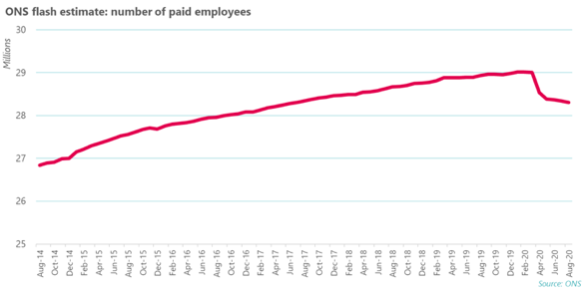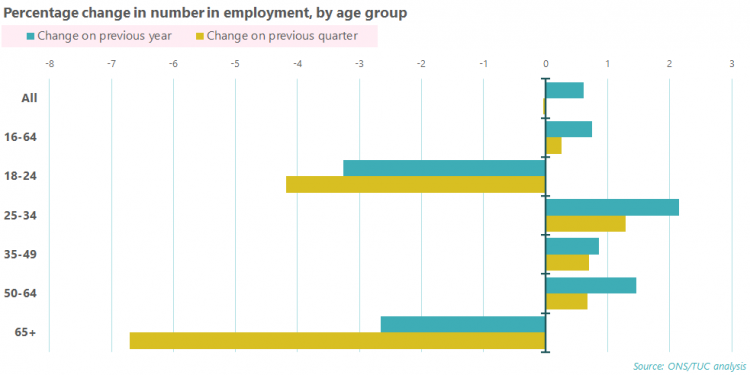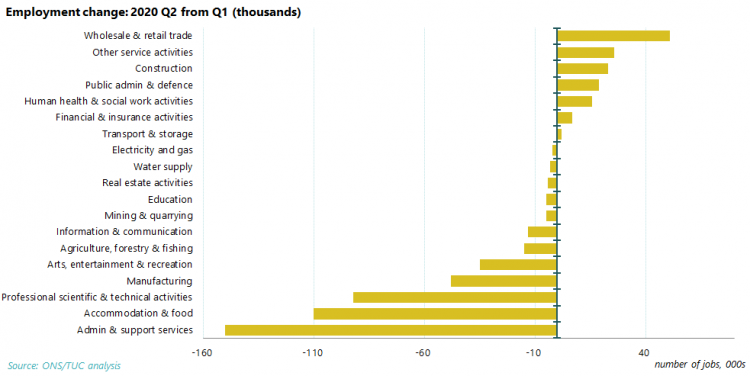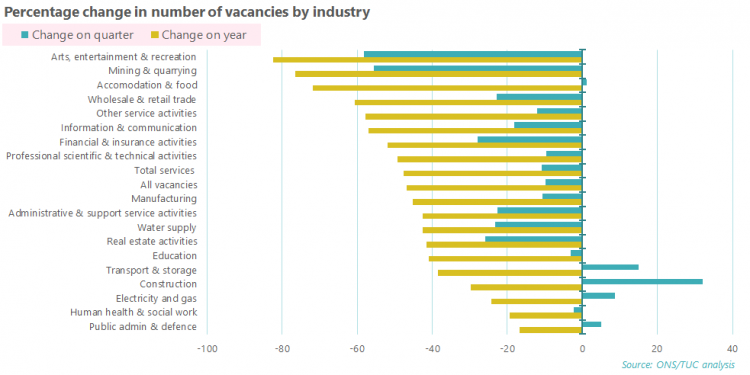An unemployment crisis is coming. The government must act now to prevent it
With a rise in unemployment, the biggest fall in jobs for 18-24 year olds and those over 65 on record, and steep declines in employment in a number of industries, it’s becoming increasingly clear that the government must act if it wants to stave off an unemployment crisis.
Flash estimates have long predicted a steep fall in jobs, and these are now coming through in the wider statistics.
Today’s ONS flash estimate shows that between March - when the pandemic began - and August, the number of paid employees dropped by 695,000 people.

While the flash estimates have been showing falls in employment for a few months, this is yet to fully come through in the usual ONS employment stats, which are based on the Labour Force Survey (LFS). In May-July 2020, total employment remained stagnant since the previous quarter, and remains higher than it was at the same point the year before.
However, this masks a drastic fall in employment among younger and older people. This hints at the unequal impact of the pandemic that’s playing out along existing age inequalities in the labour market. These two age groups are also more likely to be in insecure work, more likely to be furloughed, and more likely to be paid less.

The ONS has also published the first industry breakdown of employment for the second quarter. In contrast to the negligible fall in employment in the LFS figures, employment is shown to have fallen by 350,000 across all jobs.
The admin and support service industry and the accommodation and food industry have been particularly badly hit. It’s worth noting that these statistics differ from the LFS, a households survey, as they are also based on employer surveys.

Redundancies and vacancies
As well as drops in employment, there has been a rise in unemployment and a leap in redundancies.
In May-to-July 2020, unemployment rose by 104,000 compared to the same period of last year. This is the largest annual increase since early 2012. Of this increase, around 60 per cent was accounted for by those in the 18-24 age bracket.
The number of redundancies rocketed by 45 per cent (48,000) compared to the previous quarter. This particularly affected women, with a 79 per cent (34,000) rise in the number of women being made redundant. Again, the impact of this pandemic is playing out along the lines of existing inequalities.
For those who have lost their jobs, there aren’t many new ones about. The number of vacancies is around half of what it was in the same period last year and around the level of the global financial crisis.
The changes in the number of vacancies also reiterates how the pandemic has hit some industries harder than others.
Arts, entertainment and recreation, and accommodation and food have seen big falls in vacancies, but they’ve also been the worst hit by other measures. As of August, 40 per cent of the arts and entertainment sector workforce and 30 per cent of the accommodation and food sector workforce remains on furlough. Both industries saw the highest rates of businesses pausing trade during the pandemic.

The role of the furlough scheme
Falling employment levels would be much worse if not for the furlough scheme. The ONS business survey shows that around 11 per cent of the workforce was still on furlough in mid-August, equivalent to around 3 million employees.
This shows both the positive impact of the scheme and how wrong the government would be to continue with its current plans to end it in October.
Instead, the government must act fast to extend the scheme by introducing a new jobs protection and upskilling plan.
The government must also launch a public sector jobs drive. TUC research has identified 600,000 existing public service vacancies and staff gaps that could quickly be filled to boost employment.
Investment in jobs
It’s also important that the government begins to work towards a future with decent, well-paid, green jobs. By fast-tracking investment in green infrastructure, the government could create around 1.25 million jobs over the next two years.
All this must be underpinned by a strong social safety net. For this, we need an emergency overhaul of Universal Credit, which will be the first step towards creating a more generous, less punitive social security system.
An unemployment crisis is not inevitable. It is a choice. The government can choose to let us return to the high unemployment rates last seen in the 1980s, or it can act to protect viable businesses that are going through a tough time, but have a long term future. It can choose to let us fall into an unemployment crisis, or it can invest in decent, well-paid jobs that will help people to stay in work.
Stay Updated
Want to hear about our latest news and blogs?
Sign up now to get it straight to your inbox
